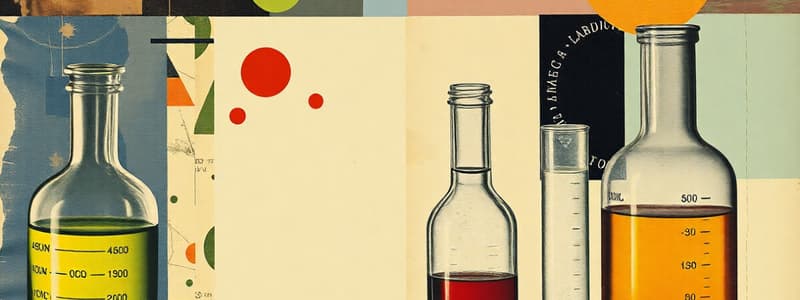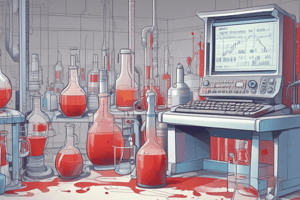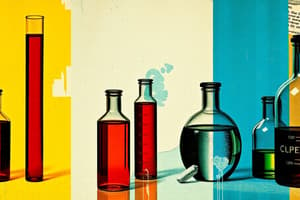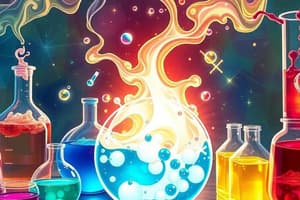Podcast
Questions and Answers
What color does blue litmus paper turn in an acidic solution?
What color does blue litmus paper turn in an acidic solution?
Red
Name one common acid found in a science laboratory.
Name one common acid found in a science laboratory.
Hydrochloric acid (HCl)
What type of indicator changes its odor in acidic or basic media?
What type of indicator changes its odor in acidic or basic media?
Olfactory indicator
What is the chemical formula for sulfuric acid?
What is the chemical formula for sulfuric acid?
Is sodium hydroxide (NaOH) an acid or a base?
Is sodium hydroxide (NaOH) an acid or a base?
What color does red litmus paper turn in a basic solution?
What color does red litmus paper turn in a basic solution?
If a substance does not change the color of red litmus paper, is it acidic?
If a substance does not change the color of red litmus paper, is it acidic?
What is the chemical formula for acetic acid?
What is the chemical formula for acetic acid?
You are given three unlabeled beakers, one with a strong acid, one with a strong base, and one with distilled water. Using only red litmus paper, describe a procedure to correctly identify each beaker's contents.
You are given three unlabeled beakers, one with a strong acid, one with a strong base, and one with distilled water. Using only red litmus paper, describe a procedure to correctly identify each beaker's contents.
A student tests a solution with phenolphthalein and observes that it remains colorless. Can the student definitively conclude that the solution is acidic? Explain your reasoning.
A student tests a solution with phenolphthalein and observes that it remains colorless. Can the student definitively conclude that the solution is acidic? Explain your reasoning.
Explain how olfactory indicators work, and provide an example using a common household item.
Explain how olfactory indicators work, and provide an example using a common household item.
A solution turns methyl orange yellow. What does this indicate about the pH of the solution?
A solution turns methyl orange yellow. What does this indicate about the pH of the solution?
Why is it important to use a variety of indicators instead of just one when determining whether a solution is acidic or basic?
Why is it important to use a variety of indicators instead of just one when determining whether a solution is acidic or basic?
Describe the expected observations when testing hydrochloric acid (HCl) with both blue litmus paper and methyl orange.
Describe the expected observations when testing hydrochloric acid (HCl) with both blue litmus paper and methyl orange.
If you accidentally spill a strong acid on your skin in the lab, what is the immediate first aid procedure you should follow?
If you accidentally spill a strong acid on your skin in the lab, what is the immediate first aid procedure you should follow?
What is the purpose of including distilled water as a control in experiments testing the properties of acids and bases?
What is the purpose of including distilled water as a control in experiments testing the properties of acids and bases?
Explain why it is not advisable to use olfactory indicators for very strong acids or bases.
Explain why it is not advisable to use olfactory indicators for very strong acids or bases.
A student finds that a solution has no effect on either red or blue litmus paper. What can they conclude about the nature of the solution, and what further test could they perform?
A student finds that a solution has no effect on either red or blue litmus paper. What can they conclude about the nature of the solution, and what further test could they perform?
Given only red litmus paper, describe a step-by-step procedure to differentiate between distilled water, an acidic solution, and a basic solution.
Given only red litmus paper, describe a step-by-step procedure to differentiate between distilled water, an acidic solution, and a basic solution.
Explain how olfactory indicators function, providing a specific example using the information given.
Explain how olfactory indicators function, providing a specific example using the information given.
You are given three unknown solutions: hydrochloric acid (HCl), sodium hydroxide (NaOH), and distilled water. Explain how you would use both red litmus paper and phenolphthalein to identify each solution.
You are given three unknown solutions: hydrochloric acid (HCl), sodium hydroxide (NaOH), and distilled water. Explain how you would use both red litmus paper and phenolphthalein to identify each solution.
A student performs Activity 2.1 and observes that a certain solution turns red litmus blue and phenolphthalein pink. What can be definitively concluded about the chemical nature of this solution?
A student performs Activity 2.1 and observes that a certain solution turns red litmus blue and phenolphthalein pink. What can be definitively concluded about the chemical nature of this solution?
Describe a scenario where using an olfactory indicator would be more advantageous than using litmus paper to identify whether a solution is acidic or basic.
Describe a scenario where using an olfactory indicator would be more advantageous than using litmus paper to identify whether a solution is acidic or basic.
Explain why testing a solution with multiple indicators, such as both litmus paper and phenolphthalein, provides more reliable results than using only one indicator.
Explain why testing a solution with multiple indicators, such as both litmus paper and phenolphthalein, provides more reliable results than using only one indicator.
A student finds that a solution does not change the color of red litmus paper, blue litmus paper, or phenolphthalein. What can the student conclude about the solution, and what further test could be performed to confirm this?
A student finds that a solution does not change the color of red litmus paper, blue litmus paper, or phenolphthalein. What can the student conclude about the solution, and what further test could be performed to confirm this?
If you accidentally contaminate a sample of distilled water with a small amount of hydrochloric acid (HCl), how would this affect the results when testing with litmus paper and phenolphthalein?
If you accidentally contaminate a sample of distilled water with a small amount of hydrochloric acid (HCl), how would this affect the results when testing with litmus paper and phenolphthalein?
Describe the limitations of using universal indicators compared to using specific indicators like litmus paper or phenolphthalein.
Describe the limitations of using universal indicators compared to using specific indicators like litmus paper or phenolphthalein.
Explain how the strength of an acid or base affects the degree of color change observed with indicators like litmus paper and phenolphthalein.
Explain how the strength of an acid or base affects the degree of color change observed with indicators like litmus paper and phenolphthalein.
Consider a scenario where you have synthesized a novel amphoteric molecule with unknown pKa values. Design an experiment, utilizing only a pH meter and standard titration techniques, to elucidate the precise pKa values and buffering capacity of this molecule in an aqueous solution at 25°C. Furthermore, explain how you would determine the isoelectric point (pI) from the obtained titration curve.
Consider a scenario where you have synthesized a novel amphoteric molecule with unknown pKa values. Design an experiment, utilizing only a pH meter and standard titration techniques, to elucidate the precise pKa values and buffering capacity of this molecule in an aqueous solution at 25°C. Furthermore, explain how you would determine the isoelectric point (pI) from the obtained titration curve.
Imagine you are tasked with developing a highly sensitive and selective sensor for detecting trace amounts of a specific weak acid in a complex environmental sample. Propose a novel sensor design, incorporating a suitable indicator dye and a signal transduction mechanism, that can accurately quantify the concentration of the weak acid even in the presence of other interfering acidic or basic species. Detail the chemical principles underpinning your sensor's operation and discuss potential limitations.
Imagine you are tasked with developing a highly sensitive and selective sensor for detecting trace amounts of a specific weak acid in a complex environmental sample. Propose a novel sensor design, incorporating a suitable indicator dye and a signal transduction mechanism, that can accurately quantify the concentration of the weak acid even in the presence of other interfering acidic or basic species. Detail the chemical principles underpinning your sensor's operation and discuss potential limitations.
Aqueous solutions of $HCl$ and $CH_3COOH$ exhibit vastly different conductivities at the same molar concentration. Explain this phenomenon in terms of ion mobility, degree of dissociation, and the influence of the solvent structure on ion transport. Furthermore, elaborate on how one could experimentally determine the molar conductivity at infinite dilution ($\Lambda_0$) for both acids and discuss its significance.
Aqueous solutions of $HCl$ and $CH_3COOH$ exhibit vastly different conductivities at the same molar concentration. Explain this phenomenon in terms of ion mobility, degree of dissociation, and the influence of the solvent structure on ion transport. Furthermore, elaborate on how one could experimentally determine the molar conductivity at infinite dilution ($\Lambda_0$) for both acids and discuss its significance.
Consider the equilibrium of a monoprotic weak acid, $HA$, in water. Derive an expression for the pH of the solution as a function of the acid's initial concentration ($C_0$) and its acid dissociation constant ($K_a$). Then, analyze how the pH changes as the ionic strength of the solution is increased by the addition of an inert salt (e.g., $NaCl$), taking into account activity coefficients.
Consider the equilibrium of a monoprotic weak acid, $HA$, in water. Derive an expression for the pH of the solution as a function of the acid's initial concentration ($C_0$) and its acid dissociation constant ($K_a$). Then, analyze how the pH changes as the ionic strength of the solution is increased by the addition of an inert salt (e.g., $NaCl$), taking into account activity coefficients.
Design a microfluidic device capable of performing continuous pH titrations of extremely small sample volumes (on the order of nanoliters). Describe the key components of the device, including the fluid handling system, the pH sensor, and the data acquisition and processing system. How would you calibrate the device and ensure accurate pH measurements in such a confined environment?
Design a microfluidic device capable of performing continuous pH titrations of extremely small sample volumes (on the order of nanoliters). Describe the key components of the device, including the fluid handling system, the pH sensor, and the data acquisition and processing system. How would you calibrate the device and ensure accurate pH measurements in such a confined environment?
Investigate the effect of pressure on the ionization constant ($K_w$) of water at a constant temperature. Derive a thermodynamic relationship that expresses the pressure dependence of $K_w$ in terms of the partial molar volumes of the involved species ($H_2O$, $H^+$, $OH^-$). Predict whether increasing pressure will favor or disfavor the ionization of water and explain your reasoning.
Investigate the effect of pressure on the ionization constant ($K_w$) of water at a constant temperature. Derive a thermodynamic relationship that expresses the pressure dependence of $K_w$ in terms of the partial molar volumes of the involved species ($H_2O$, $H^+$, $OH^-$). Predict whether increasing pressure will favor or disfavor the ionization of water and explain your reasoning.
Design a 'universal indicator' solution that exhibits distinct and easily distinguishable color changes across the entire pH range (0-14). Justify your choice of indicator dyes based on their pKa values and spectral properties, and explain how you would optimize the dye concentrations to achieve maximum color contrast and sensitivity.
Design a 'universal indicator' solution that exhibits distinct and easily distinguishable color changes across the entire pH range (0-14). Justify your choice of indicator dyes based on their pKa values and spectral properties, and explain how you would optimize the dye concentrations to achieve maximum color contrast and sensitivity.
Describe the principles behind a potentiometric titration using a glass electrode to determine the concentration of a weak base. Explain the Nernst equation in the context of the glass electrode and how it relates the measured potential to the pH of the solution. Furthermore, discuss the limitations of the glass electrode at extreme pH values (very acidic or very basic) and the possible sources of error.
Describe the principles behind a potentiometric titration using a glass electrode to determine the concentration of a weak base. Explain the Nernst equation in the context of the glass electrode and how it relates the measured potential to the pH of the solution. Furthermore, discuss the limitations of the glass electrode at extreme pH values (very acidic or very basic) and the possible sources of error.
You have discovered a new extremophile microorganism that thrives in highly acidic environments (pH < 1). Design a series of experiments to investigate the mechanisms by which this organism maintains its intracellular pH within a physiologically compatible range. Focus on the potential roles of membrane transport proteins, intracellular buffering systems, and metabolic adaptations.
You have discovered a new extremophile microorganism that thrives in highly acidic environments (pH < 1). Design a series of experiments to investigate the mechanisms by which this organism maintains its intracellular pH within a physiologically compatible range. Focus on the potential roles of membrane transport proteins, intracellular buffering systems, and metabolic adaptations.
Consider a redox reaction occurring in an electrochemical cell, where the half-reactions involve acidic or basic species. Explain how changes in pH can affect the redox potential of the half-cells and, consequently, the overall cell potential. Provide specific examples of redox reactions that are highly pH-dependent and discuss their relevance in biological or industrial applications.
Consider a redox reaction occurring in an electrochemical cell, where the half-reactions involve acidic or basic species. Explain how changes in pH can affect the redox potential of the half-cells and, consequently, the overall cell potential. Provide specific examples of redox reactions that are highly pH-dependent and discuss their relevance in biological or industrial applications.
You are provided with three test tubes: one with distilled water, one with an acidic solution, and one with a basic solution. Using only red litmus paper, how can you identify the contents of each test tube?
You are provided with three test tubes: one with distilled water, one with an acidic solution, and one with a basic solution. Using only red litmus paper, how can you identify the contents of each test tube?
What is the purpose of using olfactory indicators? Give an example of one.
What is the purpose of using olfactory indicators? Give an example of one.
If a solution does NOT change the color of red litmus paper, is it necessarily neutral? Explain.
If a solution does NOT change the color of red litmus paper, is it necessarily neutral? Explain.
Write the balanced chemical equation for the reaction between hydrochloric acid (HCl) and sodium hydroxide (NaOH).
Write the balanced chemical equation for the reaction between hydrochloric acid (HCl) and sodium hydroxide (NaOH).
Explain how to prepare cloth strips with chopped onions to be used as an olfactory indicator.
Explain how to prepare cloth strips with chopped onions to be used as an olfactory indicator.
Why is it important to use a variety of indicators when testing for acids and bases, rather than relying on just one?
Why is it important to use a variety of indicators when testing for acids and bases, rather than relying on just one?
A solution turns methyl orange yellow. Is the solution acidic or basic?
A solution turns methyl orange yellow. Is the solution acidic or basic?
Formulate a detailed procedure to differentiate between dilute hydrochloric acid and dilute sulfuric acid using only common laboratory chemicals (excluding specialized reagents or equipment like a pH meter).
Formulate a detailed procedure to differentiate between dilute hydrochloric acid and dilute sulfuric acid using only common laboratory chemicals (excluding specialized reagents or equipment like a pH meter).
Is there a theoretical scenario where an olfactory indicator might fail to accurately determine the acidity or basicity of a solution? Explain your reasoning.
Is there a theoretical scenario where an olfactory indicator might fail to accurately determine the acidity or basicity of a solution? Explain your reasoning.
Flashcards
Red Litmus Paper
Red Litmus Paper
Paper that turns blue in basic solutions and remains red in acidic solutions.
Acidic Solution
Acidic Solution
A solution with a pH less than 7 that turns blue litmus paper red.
Basic Solution
Basic Solution
A solution with a pH greater than 7 that turns red litmus paper blue.
Indicators
Indicators
Signup and view all the flashcards
Phenolphthalein
Phenolphthalein
Signup and view all the flashcards
Olfactory Indicators
Olfactory Indicators
Signup and view all the flashcards
Hydrochloric Acid (HCl)
Hydrochloric Acid (HCl)
Signup and view all the flashcards
Sodium Hydroxide (NaOH)
Sodium Hydroxide (NaOH)
Signup and view all the flashcards
Neutral Solution
Neutral Solution
Signup and view all the flashcards
pH Scale
pH Scale
Signup and view all the flashcards
Identifying Solutions
Identifying Solutions
Signup and view all the flashcards
Chemical Indicators
Chemical Indicators
Signup and view all the flashcards
Red Litmus Reaction
Red Litmus Reaction
Signup and view all the flashcards
Blue Litmus Reaction
Blue Litmus Reaction
Signup and view all the flashcards
Acidic Indicator Color
Acidic Indicator Color
Signup and view all the flashcards
Basic Indicator Color
Basic Indicator Color
Signup and view all the flashcards
Activity with Onions
Activity with Onions
Signup and view all the flashcards
Testing with Phenolphthalein
Testing with Phenolphthalein
Signup and view all the flashcards
Types of Acids
Types of Acids
Signup and view all the flashcards
Acid-base Test
Acid-base Test
Signup and view all the flashcards
Testing with Blue Litmus
Testing with Blue Litmus
Signup and view all the flashcards
Chopped Onion Test
Chopped Onion Test
Signup and view all the flashcards
Color Change of Indicators
Color Change of Indicators
Signup and view all the flashcards
Testing Acidic Solutions
Testing Acidic Solutions
Signup and view all the flashcards
Testing Basic Solutions
Testing Basic Solutions
Signup and view all the flashcards
Phenolphthalein Reaction
Phenolphthalein Reaction
Signup and view all the flashcards
Common Strong Bases
Common Strong Bases
Signup and view all the flashcards
Testing with Red Litmus Paper
Testing with Red Litmus Paper
Signup and view all the flashcards
Indicators and Color Change
Indicators and Color Change
Signup and view all the flashcards
Experimental Testing
Experimental Testing
Signup and view all the flashcards
Color Observations Table
Color Observations Table
Signup and view all the flashcards
Acid and Base Identification
Acid and Base Identification
Signup and view all the flashcards
Study Notes
Acids and Bases in the Laboratory
- Collect solutions: Hydrochloric acid (HCl), sulfuric acid (H₂SO₄), nitric acid (HNO₃), acetic acid (CH₃COOH), sodium hydroxide (NaOH), calcium hydroxide [Ca(OH)₂], potassium hydroxide (KOH), magnesium hydroxide [Mg(OH)₂], ammonium hydroxide (NH₄OH)
- Test solutions: Use red litmus, blue litmus, phenolphthalein, and methyl orange solutions to test each solution
- Observe changes: Note any color changes in the indicators, record those changes
- Record observations: Tabulate your findings in a table (e.g., using a table like Table 2.1 in the text)
Identifying Acids and Bases
- Indicators: Substances that change color to indicate whether a substance is acidic or basic
- Color changes: Indicators can change color in acidic or basic solutions. Specific color changes are noted
- Odor changes: Some substances change odor in acidic or basic solutions; these are olfactory indicators
- Onion strips: Finely chopped onions in a plastic bag with cloth strips left overnight in the fridge can be used as olfactory indicators to test for acids and bases. Check their odor. Put a few drops of dilute HCl on one strip, and a few drops of dilute NaOH on the other.
Studying That Suits You
Use AI to generate personalized quizzes and flashcards to suit your learning preferences.




